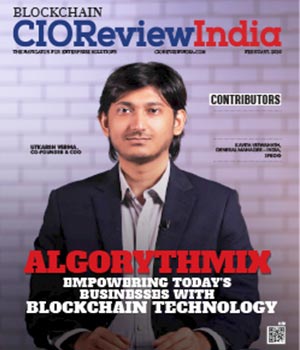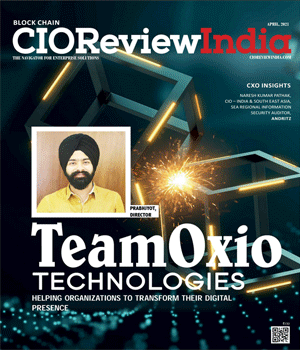
Discovering the Potential of Blockchain within an Organization
Rupinder Goel, CIO & Sr. Vice President IT-Corporate Operations, Tata Communications
 Blockchain is a technology that created the backbone of a new type of internet, originally devised with decentralised ledger, cryptography and consensus to solve major concerns such as centralised control, mid-layer stage gates, reconciliation, etc. Leveraging a universal peer-to-peer network to assure transparent veracity of value exchanged between parties, Blockchain seems likely to benefit several significant businesses that rely upon third parties. It could even prove to be a wider force for decentralisation, transparency and integrity in these businesses – leading to extensive transformation in supply chain and finance as well as typical product companies and telcos. But ultimately, the extent to which the potential of this new technology is realised substantially depends on how well investors and innovators influence its growth and development.
Blockchain is a technology that created the backbone of a new type of internet, originally devised with decentralised ledger, cryptography and consensus to solve major concerns such as centralised control, mid-layer stage gates, reconciliation, etc. Leveraging a universal peer-to-peer network to assure transparent veracity of value exchanged between parties, Blockchain seems likely to benefit several significant businesses that rely upon third parties. It could even prove to be a wider force for decentralisation, transparency and integrity in these businesses – leading to extensive transformation in supply chain and finance as well as typical product companies and telcos. But ultimately, the extent to which the potential of this new technology is realised substantially depends on how well investors and innovators influence its growth and development.
Distributed as open source, it provides four major disruptive technologies and enhanced functionalities that underline its value even more compared to traditional mindsets and technologies; shared ledger, cryptography, consensus and smart contract.
Why Do We Need Blockchain?
Put simply, Blockchain allows us to trust strangers. It is a technology that provides solutions so any person can get involved and transact with an unknown party with the confidence that the transaction cannot be hijacked or jeopardised by any technological means.
We have been dealing with such transactions without Blockchain for decades using a trusted ‘middleman’ approach. People live their life precariously in the digital world by relying on third parties for the security, authenticity and confidentiality of their digital assets or any digital data. The fact remains that these third-party foundations can be hacked, cracked, manipulated or compromised – possibly leading to substantial loss. This is where Blockchain technology comes into play. It has the potential to modernise the digital world by enabling a distributed consensus where every online digital transaction involving digital assets can be verified at any time without compromising the privacy of the digital assets and participants involved. That is also where distributed ledger and consensus provide flexibility to each other. Speedy transaction, agility, transparency and safety are the main advantages Blockchain can bring to any organisation to transform the overall structure with reduced turnaround time (TAT) in turn boosting revenue and productivity of the company.
How Blockchain Can Transform Our Work
Blockchain can bring significant advantages through its basic functionalities like shared ledger, consensus, smart contract and cryptography. All these functionalities help make Blockchain stronger and sharper compared to other traditional decentralised applications.
• Shared ledger: A shared or decentralised ledger can be described as a ledger of any digital transactions or contracts maintained in decentralised form across different locations, eliminating the need of a central authority to keep a check against any kind of manipulation. All information is securely and accurately stored using cryptography and can be accessed using keys and cryptographic digital signatures. Once the information is stored, it becomes part of an immutable database and is governed by the rules and regulations of the network. While centralised ledgers are prone to cyber-attack, distributed ledgers are inherently harder to target because all the distributed copies need to be attacked simultaneously to be successful. Also, once the block in the Blockchain framework is created, it’s automatically hashed and replicated in a decentralised manner, so participants will not be able to alter the digital asset or information.
• Consensus: There are four main methods of finding consensus in a Blockchain (and all distributed systems).
These four methods are:
1. The practical byzantine fault tolerance algorithm (PBFT)
2. The proof-of-work algorithm (PoW)
3. The proof-of-stake algorithm (PoS)
4. The delegated proof-of-stake algorithm (DPoS)
Each party maintains an internal state (ongoing specific information or status). When a party or node receives a message, they use the message in conjunction with their internal state to run a computation or procedure. This computation in turn tells that individual party what to subtract from the message in question. Then, after reaching its individual decision about the new message the party shares that decision with all the other parties in the system. A consensus decision is determined based on the total decisions submitted by all nodes. Among other considerations, this method of establishing consensus requires less effort than others. However, it comes at the cost of anonymity on the system. Decentralised ledgers can bring down the monopoly in any traditional transaction and speed up overall transactional time.
- Security: cryptography provides security for every digital transaction:
- Integrity of ledger: to maintain the integrity of the ledger, cryptography uses hashing functionality so that none of the participants can alter or tamper with the triggered transaction.
- Authenticity of transactions: to provide original and genuine authenticity of any transaction, cryptography uses the ECDSA algorithm to generate a unique digital signature. Every participant provides their authenticity using their unique digital signature for every transaction.
- Privacy of transactions: every digital transaction is encrypted with EC point encryption provided by Open SSL. Due to this extra layer of security, cryptography can provide privacy for any unique transaction.
- Identity of participants: each participant’s identity is based on their public and private key. Every participant generates their unique private key, creating their own digital signature for identification.
All these functionalities are provided by the cryptography, which in turn secures the transaction in Blockchain framework.
- Smart contract: smart contract is a term used to describe computer program code that is capable of facilitating, executing and enforcing the negotiation or performance of an agreement (i.e. contract) using Blockchain technology. The entire process is automated and can act as a complement or substitute for legal contracts where the terms of the smart contract are recorded in a computer language as a set of instructions. These computer programs act as agreements where the terms of the agreement or business logic of a transaction can be pre-programmed with the ability to self-execute and self-enforce. This can revolutionise the way contracts are executed and negotiated across all industries and create security and transparency in each transaction.
What Blockchain Can Bring to the Organisation
During usability research within Tata Communications, multiple ways were identified in which organisations across many industries could digitally transform themselves and generate value with Blockchain as shown in the image below.
The Future of Blockchain
In today’s world, how fruitful is the widely-used concept of Bitcoin? It’s just the start of an infinite contest – with many other notions likely to evolve based on Blockchain essentials, bringing revolution not only to society and industry, but also in human thought processes.
While Blockchain may have become common grammar for geeks and the talk of the town in every organisation, the essentials of Blockchain can solve lots of everyday industry wide challenges. As we move ahead, Blockchain becoming ubiquitous in all business operations is a near certainty. It is therefore imperative for all organisations to find and embrace Blockchain, however cherished current solutions may appear today. Innovative organisations must take it upon themselves to shape the future using Blockchain prerequisites.
CIO Viewpoint
Why Foolproof Facial Recognition Is Key Against...
By Joseph Sudheer Thumma, Global CEO & MD, Magellanic Cloud
National Technology Day 2025: Powering Progress...
By CIOTech Outlook Team
Aligning IT Roadmap with Business Objectives: A...
By Subhash singh Punjabi, CISO & Head Enterprise Architecture, Deepak Fertilisers & Petrochemicals Corporation Ltd
CXO Insights
Blockchain: Revolutionizing Industries, One...
By Dr. Arvind Deendayalan, Global Practice Head - Blockchain, Infovision
Dissecting The Role Of DevOps In Contemporary ERA
By Kavita Viswanath, General Manager - India, JFrog
Advisory FOR CXOs At A Crossroads To Modernize...


.jpg)
.jpg)






